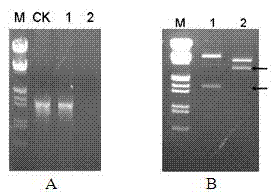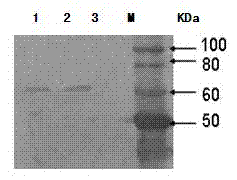Enriching method for transcription factor target gene through co-immunoprecititation of protein bead
A technology for transcription factors and proteins, applied in the field of molecular biology, can solve the problem of not being able to determine whether the transcription factor regulates the target gene directly or indirectly, and achieves the effects of high specificity, improved specificity and high cleaning efficiency.
- Summary
- Abstract
- Description
- Claims
- Application Information
AI Technical Summary
Problems solved by technology
Method used
Image
Examples
preparation example Construction
[0032] 6. Preparation of linker and its connection with enzyme-cut DNA
[0033] Different linker sequences were designed for the restriction enzymes used in step 5, and ligated with the digested DNA products. For example, the four oligonucleotide primers synthesized for EcoRI and MseI are: EcoRI linker 1: CTCGTAGACTGCGTACC and EcoRI linker 2: AATTGGTACGCAGTCTAC; and MseI linker 1: GACGATGAGTCCTGAG and MseI linker 2: TACTCAGGACTCAT, and then annealed in an equimolar ratio ( The reaction conditions are: 94°C, 10min; 37°C, 30min) to form EcoR I and Mse Double-stranded linkers AdpterE and AdpterM at I cohesive ends. via T 4 DNA ligase acts to cut the two ends of DNA fragments and anneal to form specific adapters. And use the ligation product as a template for amplification. If yes Eco RI and Mse For the double enzyme-digested ligation product of I, primers EcoRI + A: GACTGCGTACCAATTCA and MseI + C: GATGAGTCCTGAGTAAC can be used to amplify the ligation product.
[0034]...
Embodiment 1
[0038] Example 1: Enrichment of Rice WRKY Transcription Factor SUSIRI Target Genes by Immunomagnetic Beads
[0039] rice gene SUSIRI It is a transcription factor gene of WRKY family cloned from the young panicle of japonica rice Nipponbare. In order to obtain its target gene to elucidate its biological function, the cloned SUSIRI The full-length cDNA of the gene ( SUSIRI For details of the gene, please refer to: Chen Jian, Lin Zhongping, Duan Yuanlin, et al. Cloning and expression analysis of a SUSIBA2-like gene in rice. Molecular Plant Breeding, 2008, 6(3): 579-582) inserted into the PET-28a vector , constructed into a prokaryotic expression vector PET-SU containing a 6XHis antigen tag at the end. Western blot detection showed that the expression vector PET-SU could express the 63kD target protein in Escherichia coli BL21(DE3) plysS after IPTG induction, and the expression of SUSIRI protein was the highest after 2-3 hours of induction. Further use magnetic beads to t...
PUM
 Login to View More
Login to View More Abstract
Description
Claims
Application Information
 Login to View More
Login to View More - R&D Engineer
- R&D Manager
- IP Professional
- Industry Leading Data Capabilities
- Powerful AI technology
- Patent DNA Extraction
Browse by: Latest US Patents, China's latest patents, Technical Efficacy Thesaurus, Application Domain, Technology Topic, Popular Technical Reports.
© 2024 PatSnap. All rights reserved.Legal|Privacy policy|Modern Slavery Act Transparency Statement|Sitemap|About US| Contact US: help@patsnap.com










